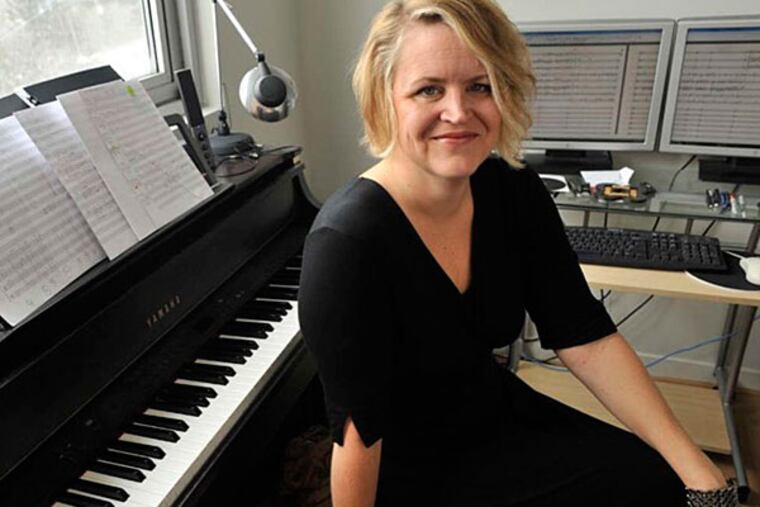Barnes-inspired classical compositions from Network for New Music
Four contemporary classical composers walk into an art museum. No punch line. But after walking in, this quartet of composers eventually walked away having penned four new compositions, which Network for New Music will premiere Friday at the Barnes Foundation - amid the art and spaces that inspired them.

Four contemporary classical composers walk into an art museum. No punch line. But after walking in, this quartet of composers eventually walked away having penned four new compositions, which Network for New Music will premiere Friday at the Barnes Foundation - amid the art and spaces that inspired them.
The obvious historical precedent is Mussorgsky's Pictures at an Exhibition, a vivid series of musical evocations connected by a recurring promenade. Each of Network's new pieces assumes a different form, chamber-music instrumentation, and philosophy about using the eye to tease out a translation for the ear.
"Music is the most incorporeal art, and, while we all accept that it is very much like a language, it is a non-representational one," said Stephen Hartke, who produced The Blue Studio, inspired by the cobalt walls in Matisse's Studio with Goldfish, which are the same shade as his own workroom in Los Angeles. "Since we all live in a real world of tangible things and events, dealing mainly with the incorporeal and the non-representational is something of a challenge. Thus composers throughout history have looked to non-musical sources - texts, visual arts, even the sciences - for a means to jump-start and even guide the creative process. Sometimes it is helpful, sometimes less so."
Hartke experienced the Barnes collection online before composing his piece. "But I did visit the Barnes once a long time ago - my piano teacher, Mary Miley, took me there when I was about 13."
He says that in writing another very early piece, he "read" a painting by Miró from left to right, reinterpreting shapes as if they were musical notation on a score. "There was nothing original about this approach - John Cage and others introduced this idea," he said.
Nothing so literal found its way into Louis Karchin's Luminous Fields, inspired by Henri Rousseau's Woman Walking in an Exotic Forest and Monkeys and Parrot in the Virgin Forest.
"But with many of Rousseau's animals running through forests, it's quite possible that the very first 'scampering' motive of the piece was directly related to this imagery," said the New York University professor. "For some reason lately, I've been asked to do this sort of thing quite a bit," he said. "A previous commission was linked to the artwork of the Italian painter Emilio Vedova; another to the work of the Dutch artist Mondrian. Of course, the link between a work of visual art and music can be casual or very specific.
"In the case of Luminous Fields, my ideas were generated by a color technique of the artist that I found intriguing, and less by the subject matter of the paintings. This would be very different from, for example, Stravinsky's inspiration from a series of Hogarth paintings that he saw at the Chicago Art Institute. These told an unfolding story, and the story became the basis for an entire opera, The Rake's Progress."
Having once lived two blocks from the new Barnes on the Parkway, Jeremy Gill knew it was Matisse to whom he would look for his piece. Like Hartke in his early work, Gill set about composing Sons Découpés by making a "sonic map" of The Dance. "Essentially, I created a musical form that imitated The Dance, and I planned to compose a work that could be followed, in time, as one scanned the mural from left to right," said Gill, now based in Boston. "After working for some weeks on this, I visited the Barnes Foundation again. When I walked into the main gallery - where The Dance is installed - I immediately knew my plan was wrong! One doesn't view The Dance from left to right; one is immersed in it, and its presence is everywhere in the gallery. So I started over . . .."
Ultimately, Gill says, he was as much inspired by some Matisse quotes as by the art itself. One of them was: What must be copied is the effort, not the accomplishment. "Hence my focusing on his working method," he said.
Kristin Kuster, a University of Michigan professor, was inspired not by the art at the Barnes but by the architecture.
"I see and hear rhythms in buildings and interiors," she said. "This can be simply ceiling-beam patterns, delicate or severe materials, staircase swoops; yet most importantly I draw upon the emotional impact I feel from experiencing a space," said Kuster, whose Folding Planes: Frosted Panes was inspired by the Barnes' light court - a space she herself has experienced only virtually.
"While I do miss the days when we were required to physically travel to hear premieres of new great pieces of music, or to see new exhibitions in art museums, I think the access we have to great art via the Internet is staggeringly cool," she said.
"Our very visual age now is evolving ever more so in exciting new ways. As a musician who remembers the debut of MTV, to see this evolution and where we are today with technology is stunning! At the same time, as we as a culture are increasingly inundated with visual imagery, I look forward to hearing how composers respond to or reject said visual age in the years to come."
MUSIC
Four new works plus William Kraft's "Kandinsky Variations"
6 p.m. Friday at the Barnes Foundation, 2025 Benjamin Franklin Parkway.
Tickets: $24-$30, includes access to galleries and talk by the four composers.
Information: 215-278-7200 or barnesfoundation.org
Additional performance: 8:15 p.m. Tuesday at West Chester University School of Music. Free admission. EndText
215-854-5611